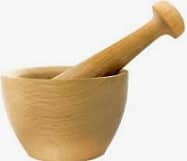You may not know it, but the etymological origin of the term mortar that concerns us now is found in Latin. Exactly it derives from the word "mortarium", which was the name for a metal box that was used to mix materials such as sand and lime.
The utensil used to crush something is called a mortar . It is an element composed of a container similar to a glass (where what is intended to be crushed , disintegrated or pulverized is placed) and an instrument known as a hand (a short, thick stick with which the substances to be ground are crushed). .
 The use of the mortar is very simple. Suppose a person wants to crumble herbs. To do this, you must place them in the mortar glass and then, with the help of your hand, break them up, exerting pressure against the surface of the container.
The use of the mortar is very simple. Suppose a person wants to crumble herbs. To do this, you must place them in the mortar glass and then, with the help of your hand, break them up, exerting pressure against the surface of the container.
Mortars can be made from ceramic , stone, wood or metal, for example. Its use is ancestral in different areas.
Starting from this meaning, words such as masher, crusher, majador and mortar are used as synonyms for mortar.
In the field of gastronomy, the mortar is used to prepare very popular recipes such as pesto or guacamole . In the first case, basil leaves, garlic and pine nuts are ground with olive oil; In the second preparation, the mortar is used to mash the avocado with tomatoes, peppers (chili) and lemon juice.
The idea of mortar is also used in the field of construction to name the mass that is generated by mixing water, sand and some binder (cement, plaster, lime, etc.). Many times additives are added to optimize its performance. Mortar is used to prepare stones or bricks, cover walls or fill spaces.
The mortar, finally, is a type of weapon that allows projectiles to be fired at an angle that exceeds 45º. Mortars eject ammunition at low speed, although when falling vertically and exploding they can cause great damage.
Taking this meaning into account, among the synonyms of mortar we find bombard, cannon and even howitzer.
This type of weapon is considered to have its origins in the 15th century. What's more, it is believed that it could have been created by Mehmed II in the year 1453 during the fall of Constantinople, which was carried out by the Ottoman Turks and is considered the event that marked the end of the Middle Ages in Europe. .
After that time, the aforementioned mortar was not very successful. However, that changed with the First World War when the English and French chose to use it, something that the Germans would later also do.
No less interesting is knowing that the first modern mortar was the one designed by Wilfred Stokes for the British side in 1915. We are referring to the Stokes mortar, which could fire up to 25 projectiles per minute and was capable of reaching a distance of approximately 730 meters. Those projectiles were made of cast iron and had a diameter of about 76 millimeters.
